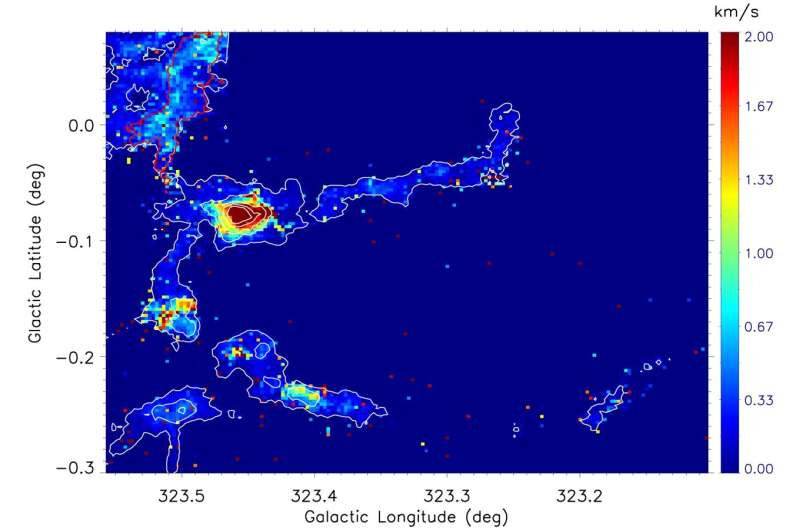This article has been reviewed according to Science X's editorial process and policies. Editors have highlighted the following attributes while ensuring the content's credibility:
fact-checked
peer-reviewed publication
trusted source
proofread
Researchers discover gravitational collapse and accretion flows in hub filament system G323.46-0.08

Hub-filament systems are ubiquitous in molecular clouds. Most dense clumps and cores are formed in filaments and play a key role in star formation process. Therefore, investigating hub-filament system is one of the best ways to understand high-mass star formation.
Recently, Ma Yingxiu, a Ph.D. student from the Xinjiang Astronomical Observatory (XAO) of the Chinese Academy of Sciences (CAS) and her collaborators have found a hub filament system G323.46-0.08, which provides evidences for gravitational collapse and accretion flows.
The study was published in Astronomy and Astrophysics on July 27.
The filaments in molecular clouds may overlap to form a hub-filament, which includes a dense hub and filaments associated with it. In a scenario of global hierarchical collapse of molecular clouds dominated by gravity, these filaments constitute channels for gas funneling from extended cloud to dense clumps in the hub. The clumps in the hub will accrete more materials from the surroundings, and they become more massive and are more likely to form high-mass star clusters.
The researchers found that the hub-filament system G323.46-0.08 consisted of three sub-filaments (F-north, F-west and F-south), with the high-mass clump AGAL323.459-0.079 located at the hub center. Large scale accretion flows were observed in F-west and F-south, indicating that they were transporting gas to the central clump.
The minimum accretion rate was estimated to be 1,216 Solar mass (M⊙) Myr-1, and filamentary accretion flows appeared to be an important mechanism for supplying materials necessary to form the central high-mass clump AGAL 323.459-0.079 and to propel the star forming activity taking place therein.
In the hub, the gas velocity gradients increased significantly, and it showed a V-shaped structure in the Positon-Velocity diagram, which traces the accelerated gas motions undergoing gravitational collapse.
The researchers obtained the best-fitting parameters from a gravitational collapse model in the study, with a hub-junction mass between 1,000 M⊙ and 1,500 M⊙ that were consistent with the observed mass 1,100 M⊙ for AGAL323.459-0.079.
"Our study strongly supports the theory of global hierarchical collapse," said Ma.
More information: Yingxiu Ma et al, Gravitational collapse and accretion flows in the hub filament system G323.46-0.08, Astronomy & Astrophysics (2023). DOI: 10.1051/0004-6361/202346248
Journal information: Astronomy & Astrophysics
Provided by Chinese Academy of Sciences





















